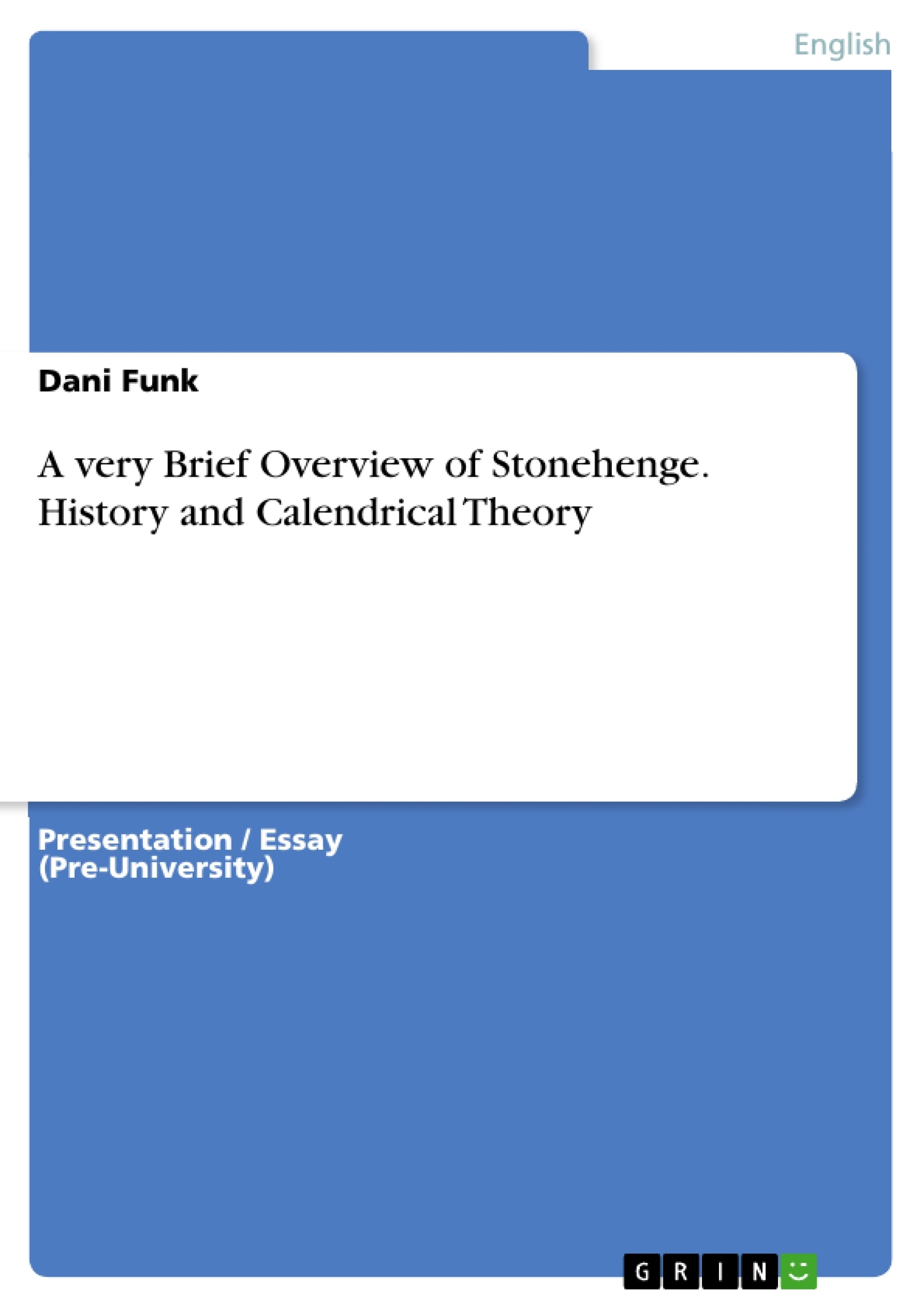Excerpt
Stonehenge is a prehistoric ritual monument which is situated on Salisbury Plain in south-western England. Stonehenge was built in the late Stone Age (called Neolithic) and the Bronze Age. It is the most famous of the megalithic monuments in England, and the most important prehistoric monument in the whole of Europe. Although its precise purpose is unknown, experts think that it it could have been a tribal gathering place or maybe also religious centre that was connected with astronomical observations.
Arrangement Of The Stones
The Stonehenge-monument consists of four concentrical arrangements of stones. In the outermost range, very big rectangular-shaped sandstone blocks (sarsen stones) that are 4 m high above the ground, form a circle which is 33 m in diameter!!!
Abbildung in dieser Leseprobe nicht enthalten
They were originally capped with lintel stones of which only a few still remain in their place today, that also formed a large continuous circle. Within this outer range is another circle of smaller bluestones, which are consisting mainly of dolerite, a coarse basaltic rock having a beautiful blueish colour. They enclose an arrangement of bluestones capped with lintels. These trilithons (means an assemblage of two uprights capped by a lintel) are about 6.5 m high. Within these trilithons stands a slab of sandstone, which is known as the “altar stone”.
The entire assemblage is surrounded by a circular ditch (104 m in diameter). On its inner side it rises into a bank. In there is a ring of 56 pits known as the Aubrey holes (named after their discoverer, the antiquarian John Aubrey) and used at a later stage as cremation burial pits.
On the north-eastern side, the bank and ditch are intersected by the Avenue, a processional causeway (23 m wide and nearly 3 km long) that is bordered by a ditch. Near the entrance to the Avenue is the Slaughter Stone (a sarsen stone) that maybe originally have stood upright.
Abbildung in dieser Leseprobe nicht enthalten
Almost opposite is the Heel Stone, which may have played a part in sightings of the sunrise at the summer solstice.
History of Stonehenge
Experts know that Stonehenge was built in several stages. The beginning was a henge monument (a ritual enclosure) which was surrounded by a bank and a ditch, similar to many others in southern England. It was around 2200 BC that it took on its unique appearance. 82 bluestones were transported from the Preseli Mountains (mountains in south-western Wales). The Altar Stone is believed to have come from a region near Milford Haven which is called Dyfed.
Stonehenge was undoubtedly built by people who must have had widespread trade connections and who established their principal settlements in the area between 1600 and 1300 BC. Its importance is reflected by the fact that the landscape around the monument is dotted by some 400 barrows, circular mounds enclosing burials, dating from between 2000 and 1500 BC. Excavation of some of these barrows has revealed rich grave goods as well as chips of bluestone similar to that found in the concentric ranges of the stones.
Between 55 BC and AD 410 the Romans tore down a number of the In addition, two uprights and a lintel west of the Altar Stone fell in January 1797, and another upright and its lintel fell in 1900. It was in 1958 when these five stones were raised and gave the monument the approximate appearance that it had during the Roman occupation of Britain. In 1953 shallow carvings were found on some of the fallen stones depict bronze axeheads of a type used in Britain between 1600 and 1400 BC and a hilted dagger of a type used in Mycenae, Greece, between 1600 and 1500 BC.
Calendrical Theory
The function of Stonehenge has long been interpreted. It could have been used to predict the summer and winter solstices, the vernal and autumnal equinoxes but also eclipses of the sun and moon. It may also have functioned as a mean of predicting the positions of the sun and moon relative to the Earth, and thereby the seasons, and therefore also as a calendar. As such it might have been the gathering place for religious ceremonies connected with the sun and moon. At Stonehenge as at other Bronze Age sites, the emphasis on the circle may also reflect the circular nature of birth and death, and the passage of the seasons.
Abbildung in dieser Leseprobe nicht enthalten
But still, although scientists, archaologists and other experts have found out so much about Stonehenge, this monument will be an unsolved mystery for long.
- Quote paper
- Dani Funk (Author), 2001, A very Brief Overview of Stonehenge. History and Calendrical Theory, Munich, GRIN Verlag, https://www.grin.com/document/101195
Publish now - it's free






















Comments